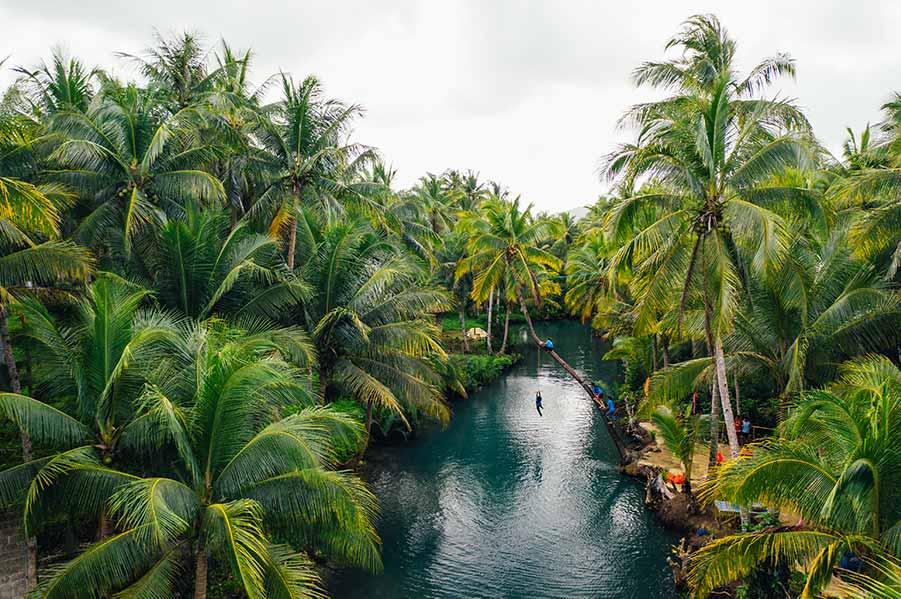Vietnam's jungle: home to an infinite number of living beings

For years now, no other place in the world has discovered so many new species as in Vietnam's jungle or in general in the Southeast Asian country. This biodiversity includes, thanks to the fact that about a quarter of the country, consists of (rain) forest. This number was even greater until it was destroyed by the Vietnam War and today's environmental destruction: two thirds (!) of Vietnam were once covered by forest. Deforestation and the conversion into usable areas are causing the areas to decline more and more. Which does not detract from the biodiversity of Vietnam's jungle – not yet! Find out more now. VIETNAM VISA ONLINE has researched for you.
The flora of the Vietnamese jungle
The country's forests consist of five characteristic floors:
- Trees that reach heights of 40 to 50 m (e.g. Terminalia myriocarpa)
- Trees with a height of 20 to 35 m (e.g. Melia azedarash)
- Banana trees and other tree species with a height between 10 and 20 m
- A bush layer (nettle plants, etc.) with a height of up to 8 m
- A layer of soil (grasses, etc.).
Fascinating representatives of the Vietnamese jungle fauna include:
- try the delicious fruit called papaya. Her name comes from the South American Indian language.
- the coveted spice plant galangal (also: galanga). This belongs to the ginger family and has many health-promoting effects.
- one of the largest fruits growing on trees. The jackfruit is up to 80 cm long.
In addition, there are jungle plants in Vietnam, the leaves of which are the size of an umbrella, as well as many other breathtaking creatures. These are by no means always plant-based...
Elephants, tigers and much more live here
- There are actually still free-living Asian elephants in the land of smiles. Unfortunately, the number is declining due to poaching. While the estimates were around 150 elephants in 2000, today there are fewer than 100 animals.
- The Indochinese tiger is one of the largest tigers in the world. Since this hunter doesn't show up often, there are no exact numbers about the population.
- The Siamese crocodile is also a feared predator in Vietnam's jungle. It lives in fresh water and is a little less than 4 m long. The animal, which belongs to the real crocodiles, is considered to be endangered.
- The Burmese python is hard to beat in terms of elegance. And not just because of their movements, but also because of their coloring. The snake feeds on birds and small mammals. The unique coloring unfortunately also means that the animals are caught by black markets and sold as pets.
- The Asian water monitor not only lives in the jungle of Vietnam, but also in canals and rivers. He has even been spotted and caught in Ho Chi Minh City. Here the imposing animal was looking for crabs, rodents, fish and birds as well as other "food". Thanks to its large tail, the water monitor is an excellent swimmer. He also uses it to ward off dangers.
Other residents of the Vietnamese jungle
- The sun bear is also called honey bear. Just like Baloo from the Jungle Book, this forest dweller loves the sticky nectar with all his heart; it makes up a large part of its diet. The unmistakable characteristic of the sun bear is the crescent on its chest. With a length of between 1.20 and 1.50 m, the bear is one of the smallest of its kind. But that doesn't mean anything: If the jungle dweller is surprised, it reacts extremely aggressively.
- With a head-trunk length of 46 – 64 cm, the white-cheeked gibbon does not get as big as the honey bear. He also eats differently from this one: the menu includes fruits, leaves, flowers, buds and insects. He finds this in the tree tops of the Vietnamese jungle.
- The Vietnamese Mossy Frog is also a small representative of the species-rich fauna. Its appearance is considered extremely strange and can be found especially on jungle cliffs and in caves. Due to its excellent camouflage properties, the frog is difficult to spot and therefore relatively well protected from its (natural) enemies.
- Plumploris (also: Nycticebus) are cute creatures with big eyes. They mostly stay in trees. To get their juice, they drill a hole in the bark with their teeth. In addition, other juices as well as fruits and insects are on the menu. As the inhabitants of the Vietnamese jungle freeze when threatened, they are easy prey for hunters and poachers. And otherwise, the cute little animals are not considered to be "speed wonders": they move very slowly, crawling.
You have to experience that!
We hope you enjoyed the little excursion into the flora and fauna of the Vietnamese jungle. Of course, this list is not nearly complete – there are simply too many species in the Southeast Asian country. One can only hope that this will not change in the future either! What are you waiting for? Apply online now and travel to the land of smiles and experience the diversity explained "firsthand"!
Created: 7/4/2020 | Modified: 6/20/2023
